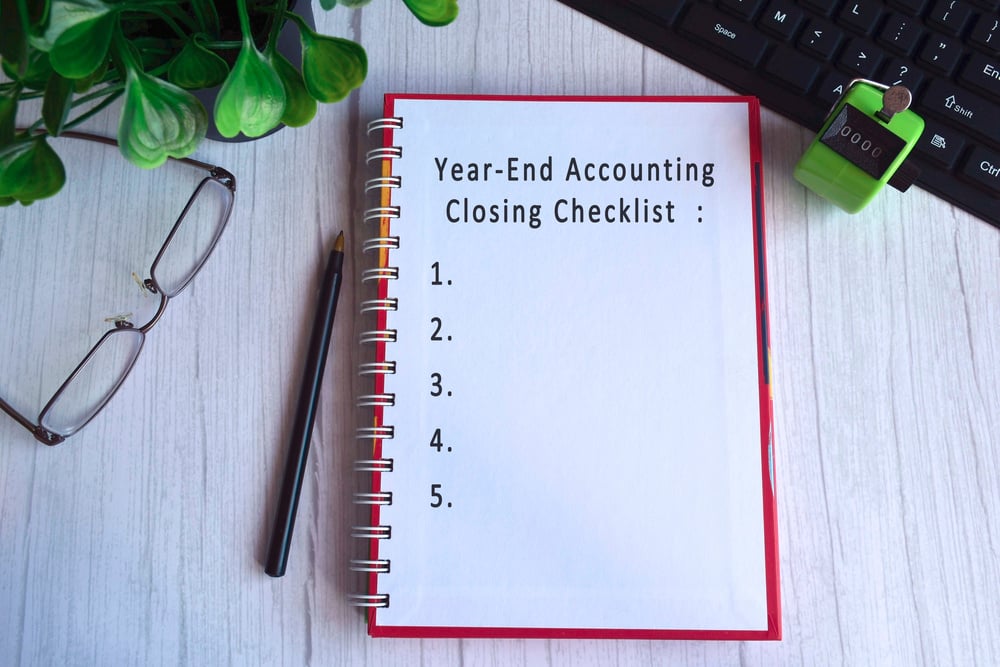Year-End Accounting Checklist: The Need-to-Knows
The end of the fiscal year represents a pivotal period for finance teams, often necessitating an effective accounting year end checklist to ensure all tasks are covered. Each year, finance professionals immerse themselves in financial records, conduct an inventory count, and finalise year-end accounts, statements, and reporting obligations.
One of the most effective ways to alleviate stress and enhance efficiency during this demanding time is by establishing and adhering to a structured workflow. To assist you in getting started, this article outlines the key steps for a successful year-end closing process, and the common pitfalls you should avoid to make to future-proof your year-end checklist.
What is the year-end close?
The year-end close, often referred to as "closing the books," is the process of thoroughly reviewing, reconciling, and verifying all financial transactions and company ledger entries from the previous fiscal year.
This process encompasses the calculation of business expenses, income, revenue, assets, investments, equity, and other financial elements. The primary objective of the year-end close is to produce a final financial statement suitable for potential external audits and to ensure it is archived as part of the organisation’s official financial records.
Accountants meticulously examine discrepancies between actual company expenditures and budgets, focusing on accounts payable and receivable. If discrepancies arise, they must liaise with relevant employees to obtain any missing information or documentation, thereby ensuring the financial ledgers are accurate and up to date. Unlike the calendar tax year, businesses have the flexibility to select a year-end closing date that aligns with their industry practices and operational cycles.
Given the necessity of submitting an accurate and timely annual report each year, it is essential for this process to be as seamless and efficient as possible.
Why is year-end closing so difficult?
Year-end closing is a critical process for any organisation, yet it is often regarded as one of the most challenging periods for finance teams (especially without an accounting year-end checklist). The complexity arises from the sheer volume of tasks involved, the need for absolute accuracy, and the tight deadlines imposed.
For many accountants, this period also overlaps with other financial reporting obligations, compounding the workload. Below are the primary reasons why year-end closing is such a demanding process:
- High Volume of Transactions to Reconcile Year-end closing requires a comprehensive review of all financial transactions for the entire fiscal year. This includes reconciling accounts payable and receivable, verifying ledger entries, and ensuring every transaction has been accurately recorded. The sheer volume of data can make this a time-consuming and laborious task.
- Stringent Accuracy Requirements Unlike routine month-end or quarter-end processes, year-end closing demands a higher level of precision. Errors in financial statements can lead to regulatory penalties, reputational damage, or failed audits. This pressure to achieve perfection often adds to the difficulty.
- Coordination Across Departments Year-end closing is not solely the responsibility of the finance team. It often requires collaboration with other departments to gather missing documentation, resolve discrepancies, or obtain explanations for unusual transactions. Coordinating with multiple stakeholders under tight deadlines can be challenging.
- Overlapping Reporting Obligations The year-end close frequently coincides with month-end and quarter-end reporting cycles, particularly for organisations with complex financial structures. This overlap increases the workload and creates additional stress for finance professionals.
- Preparation for External Audits Preparing financial records for external audits adds another layer of complexity. The process involves ensuring compliance with accounting standards, identifying potential audit risks, and providing detailed documentation for auditors. This requires significant effort and meticulous attention to detail.
- Time Constraints and Resource Limitations Year-end closing is often carried out within a compressed timeframe, leaving little room for delays or errors. Many finance teams operate with limited resources, which can exacerbate the challenge of completing the process efficiently and accurately.
Addressing these challenges requires robust planning, effective communication, and the adoption of tools and workflows designed to streamline the process. By understanding the difficulties inherent in year-end closing, organisations can take proactive steps to mitigate stress and improve outcomes. While these difficulties are legitimate and common, there are effective ways to simplify the annual close.
How to simplify the annual close with a year-end accounting checklist
Simplifying the annual close process is crucial for reducing stress and ensuring a smooth transition into the new financial year. While the year-end close can be a complex and time-consuming task, there are several strategies that can help streamline the process and make it more manageable for finance teams.
Below are key steps to simplify the year-end accounting process, including the use of an accounting year end checklist:
Maintain consistent financial tracking throughout the year
The most effective way to simplify year-end closing is to stay on top of financial records throughout the entire fiscal year. Regularly updating accounts, reconciling transactions, and managing budgets will prevent the accumulation of discrepancies that need to be addressed at the end of the year. This proactive approach ensures that much of the heavy lifting is done in advance, reducing the workload during the final close.
Standardise procedures and use year-end checklists
Establishing clear, standardised procedures for month-end, quarter-end, and year-end closings can significantly reduce confusion and inefficiency. By developing a consistent workflow and using a standardised accounting year end checklist, everyone in the finance team, including those handling payroll and inventory, will know their responsibilities and deadlines, which helps avoid last-minute rushes and ensures no steps are overlooked.
Use financial software and automation tools
Leveraging accounting software and automation tools can greatly streamline the closing process. These tools can assist with reconciliations, generate financial reports, and track outstanding transactions, reducing the need for manual intervention. Automation can also help identify discrepancies early, allowing teams to address issues promptly rather than waiting until the end of the year.
Regularly review and resolve discrepancies
Instead of waiting until the year-end close to address discrepancies, make it a habit to review financial records regularly. By identifying and resolving issues as they arise, you can avoid the stress of having to deal with a backlog of discrepancies during the closing period. This proactive approach ensures a smoother and quicker year-end close.
Plan ahead and set realistic deadlines
Planning well in advance is key to a successful year-end close. Set clear deadlines for each step of the process, from finalising transactions to preparing reports. Allocate sufficient time for each task and ensure that all necessary documentation is collected and reviewed in advance. This will help you avoid last-minute rushes and ensure the closing process runs efficiently.
By implementing these strategies, finance teams can reduce the complexity of year-end closing, improve accuracy, and ultimately save time, making the process less stressful for everyone involved.
Tip: (See the accounting year-end checklist below for a step-by-step overview)
Your year-end accounting checklist
Closing the books for the year can be a challenging task, but with the right approach and a clear plan, it becomes much more manageable. Below is a straightforward checklist to guide small businesses through the year-end accounting process, ensuring everything is in order for a smooth transition into the new financial year.
1. Review financial statements and transactions
- Check all transactions: Make sure that all financial transactions for the year have been recorded correctly, including any outstanding payments or receipts.
- Reconcile bank accounts: Compare your bank statements with your accounting records to ensure they match and there are no discrepancies.
- Review accounts payable and receivable: Ensure all invoices are accounted for, and follow up on any outstanding payments or unpaid bills.
- Verify expenses: Double-check that all business expenses have been properly recorded and categorised.
2. Reconcile your accounts
- Balance sheet review: Confirm that all assets, liabilities, and equity are correctly recorded and match the supporting documents.
- Check your trial balance: Make sure the trial balance is correct, with no errors between your debits and credits.
- Reconcile sub-ledgers: Ensure that detailed records (such as accounts payable or receivable) align with the general ledger.
3. Review assets and depreciation
- Check physical assets: If your business owns physical assets, such as equipment or property, make sure they are accurately recorded in your accounts.
- Review depreciation: Ensure depreciation is applied correctly for any long-term assets, in line with your business’s accounting practices.
- Account for any new purchases or disposals: Update your records to reflect any new assets acquired or old ones sold or disposed of during the year.
4. Prepare your financial statements
- Income statement: Prepare your income statement to summarise your business’s income and expenses for the year.
- Balance sheet: Prepare your balance sheet to show your business’s assets, liabilities, and equity at year-end.
- Cash flow statement: If applicable, prepare a cash flow statement to show how cash moved in and out of your business during the year.
- Supporting notes: If needed, add notes to explain any significant financial changes or unusual items in your statements.
5. Account for tax liabilities
- Review tax provisions: Ensure that all tax liabilities, such as income tax or VAT, are correctly calculated and recorded.
- Prepare for tax filing: Gather all necessary documents to file your business’s taxes, including income, expenses, and any deductions or credits.
- Ensure tax compliance: Double-check that your business is compliant with tax laws and regulations, and make any necessary adjustments to avoid penalties.
6. Prepare for external audit (if applicable)
- Organise supporting documents: Ensure your checklist of necessary documents, such as financial statements and supporting records, is complete if your business undergoes an external audit.
- Check internal controls: Ensure that your business has proper procedures in place to safeguard assets and ensure accurate financial reporting.
- Provide an audit trail: Make sure there is clear documentation for all financial transactions, so auditors can easily verify your records.
7. Close the books
- Post final journal entries: Make any final entries, including adjustments for payroll, to close the books for the year.
- Adjust for accruals and deferrals: If necessary, make adjustments for expenses or income that need to be recognised in the correct period.
- Verify final balances: Ensure all your accounts are accurate and ready for the new year.
8. Set budgets and financial goals for the new year
- Review last year’s performance: Look back at your financial performance to identify trends, successes, and areas for improvement.
- Prepare a budget for the new year: Set realistic income and expense targets for the upcoming year based on your business’s performance.
- Establish financial goals: Set clear financial objectives for the new year, such as increasing revenue, reducing costs, or improving profitability.
9. Document the year-end process
- Create a year-end report: Write a brief summary of the year-end process, noting any challenges you encountered and how they were resolved.
- Review accounting policies: Make sure your accounting policies are up to date and reflect any changes in accounting rules or regulations that may affect your business.
Note: An accountant can provide valuable support throughout the year-end closing process. Their expertise can help ensure that your financial records are accurate and compliant with tax laws, reducing the risk of errors or missed deadlines. By working with an accountant, you can streamline the process, avoid costly mistakes, and ensure your business is well-prepared for the year ahead.
Accounting support with Pulse Accountants
At Pulse Accountants, we understand that year-end accounting can be a daunting task for many businesses. As a technology-driven, forward-thinking accounting firm, we leverage the latest tools and software to streamline the entire year-end closing process, making it more efficient and less stressful for you. Our team of experienced accountants works closely with small businesses to ensure that all financial records are accurate, up-to-date, and compliant with the latest regulations.
We take a proactive approach with an expert year-end accounting checklist, helping you stay on top of your financials throughout the year. With our advanced cloud-based accounting systems, we can manage your transactions, track expenses, and reconcile accounts in real-time, reducing the workload at year-end. Our expertise in tax planning and financial reporting ensures that your business is prepared for any audits and can avoid costly mistakes.
By partnering with Pulse Accountants, you gain peace of mind knowing that your year-end close is in expert hands. Let us help you navigate the complexities of year-end accounting, so you can focus on growing your business with confidence.
Contact us today to learn how Pulse Accountants can simplify your year-end accounting and ensure your financials are in perfect order. Let us handle the numbers, so you can focus on what matters most—growing your business.



